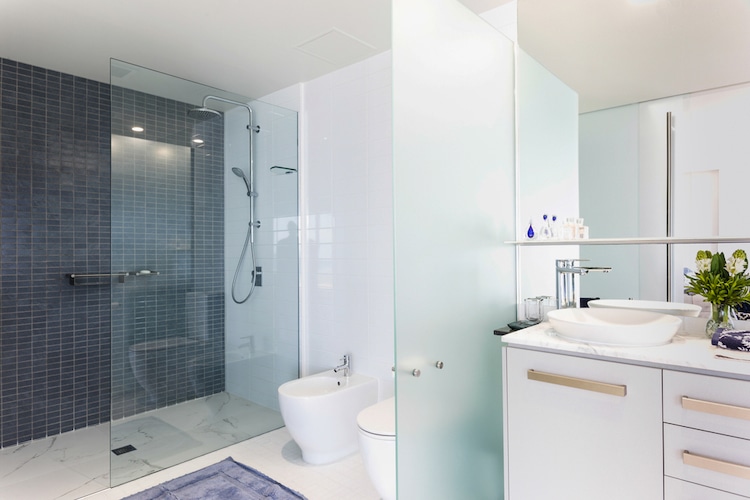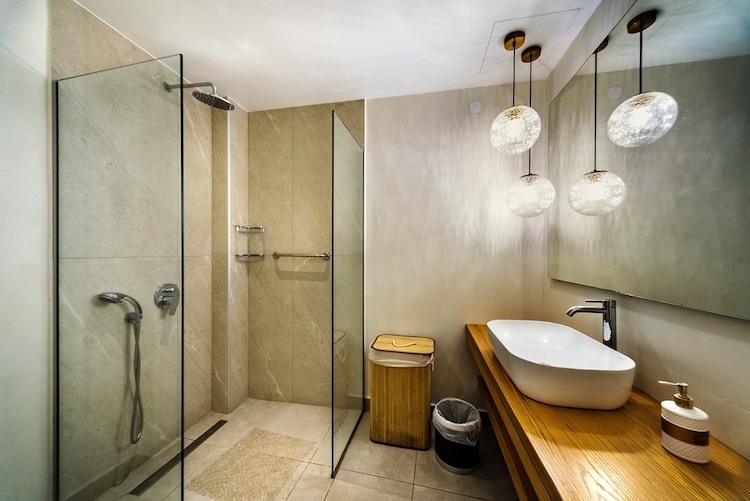What Is the Best Walk-in Shower Size?
Updated July 2024
What sets a walk-in shower apart from traditional showers is its open design, which lacks doors. This doesn’t mean the shower area is entirely open, which would make it a wet room. With a walk-in shower, half partitions or full-height glass panels are installed to prevent water from splashing outside the designated area.
This shower style is ideal if you or someone you care for has mobility impairments, dexterity issues, or struggles using a shower door and stepping over the lip of a standard shower tray. In this post, we look at the benefits, design features and the required size for walk-in showers.
Three Benefits of Walk-In Showers
Before we explain the ideal size for a walk-in shower, let’s first highlight three key benefits that make this type of shower particularly suitable for individuals with mobility issues and the elderly:
1. Walk-in showers are one of the most contemporary bathroom upgrades. They give you the look and feel of a wet room without the cost of a complete bathroom remodel.
2. A walk-in shower is easier to use than a shower enclosure with doors. It is an excellent solution for persons with restricted mobility or the elderly who find it difficult to open and close a shower door or step over the lip of a shower tray. This is a huge benefit for those with joint injuries or mobility issues.
3. Maintaining a walk-in shower is easier than a shower enclosure with doors since it only involves cleaning the glass screen, shower tray, and showerhead. When looking for a walk-in shower screen, ask about an easy-to-clean protective coating that repels grime and soap scum to keep them looking new for longer.
Related Reading: Accessible Shower Guide: Types of Showers and How They Can Help
Walk-in Shower Size Guide
Fit and comfort are two main factors to consider when choosing the size of a walk-in shower. You need to make sure that you can fit properly in the shower, and you also need to ensure there is plenty of room for every other thing in your bathroom.
A walk-in shower creates more space if you choose to remove the bath, but you can also have a walk-in shower with a bath if there is enough space. So what is the best size for a walk-in shower?
-
Minimum Walk-In Shower Size
When opting for a walk-in shower or level access shower, the first consideration should be the minimum size. We recommend a minimum space of 36 inches by 29 inches to effectively contain water within shower cubicles designed for disabled people. For those seeking the smallest possible walk-in shower, a curved surround is preferable over a rectangular enclosure, as it can help reduce unnecessary splashing.
If the shower needs to accommodate a roll-in shower chair, a minimum size of 30 inches by 60 inches is recommended to ensure easy access. If your bathroom lacks sufficient space for a walk-in shower, you might want to consider a mobility wet room as an alternative. We offer a free home survey to help you determine the best option for your home and mobility needs.
-
Standard Walk-In Shower Size
Because walk-in showers or level access showers are frequently used as bath replacements, the size of a standard walk-in shower is 60 inches by 36 inches. These proportions provide for rapid and easy installation.
You may also be able to extend the width of the walk-in shower depending on your bathroom dimensions to create a luxury walk-in shower for two people. To allow two people to shower in comfort we recommend having two separate shower heads in a double shower. You can also include many other features such as a fitted folding seat or a bench.
At Age Care Bathrooms, we can normally install your new mobility shower in just three days. Get in touch with our expert team today to book your free home survey and get a no-obligation quote.
Level Access vs Walk-in Showers
When adapting a bathroom to include a walk-in shower, numerous options and layouts exist. Two primary types of shower tray installations form the basis of this adaptation, level access showers and walk-in showers. Each type offers distinct features and benefits, catering to different needs and preferences.
-
Walk-In Showers
A walk-in shower, while similar to a regular shower cubicle, features a visible tray and requires the user to step into and onto the showering area. The shower tray in a walk-in shower typically occupies a larger portion of the floor space and is much lower than that of a regular shower cubicle. A walk-in shower does not have a door, and when designed for disabled or elderly users, it typically has a bigger entrance or opening than the size of a standard shower door.
Shower trays for disabled users in a walk-in shower are usually set at a height lower than four inches, making it relatively easy to step into. This design not only maximises the use of bathroom space but also enhances the aesthetic appeal by creating a sleek and contemporary look. Walk-in showers are particularly popular in modern bathroom designs due to their minimalistic appearance and the spacious feel they provide.
However, while walk-in showers offer ease of access compared to traditional showers, they still require a small step to enter, which might not be ideal for everyone, particularly those with significant mobility issues.
-
Level Access Showers
An alternative to the low-level walk-in shower is the level access shower. This type of shower incorporates the shower tray and the floor as a single, continuous surface with no height difference between the two. The seamless integration of the shower tray with the bathroom floor eliminates any step, providing unobstructed access to the shower area.
Level access showers are particularly beneficial for individuals with mobility difficulties, as they allow for easy entry and exit without the need to step up or down. This design is also ideal for wheelchair users or those who require the assistance of a roll-in shower chair, ensuring that the showering experience is safe and comfortable.
Providing a sleek, open-plan aesthetic in the bathroom, creating a sense of space, level access showers look modern and work in bathrooms with or without a bath. Portable shower cubicles for disabled users are ideal for mobility wet rooms if additional privacy while showering is preferred. This design not only enhances the bathroom’s visual appeal but also makes cleaning and maintenance easier due to the absence of edges and corners where dirt and grime can accumulate.
Related Reading: The Best Wheelchair Accessible Shower Options

Choosing the Right Disabled Shower Option
Deciding between a walk-in shower and a level access shower depends on various factors, including the specific needs of the users, the available space, and the overall design preferences. Walk-in showers with a low-level shower tray for disabled users are ideal for those looking for a stylish, contemporary look with relatively easy access.
Installation is quicker and easier, as this style of shower does not require the bathroom floor to be modified. Level access showers are better for individuals requiring maximum accessibility and convenience as they are wheelchair accessible.
When choosing the right shower for you or someone you care for, it’s important to consider that you may become less mobile in the future. You don’t want to install a walk-in shower only to need a level access shower a few years later.
At Age Care Bathrooms, we offer a free home survey so one of our experts can assess your bathroom space and mobility requirements. Call or use our online enquiry form, and our expert team will help you choose the best shower option.
Walk-in Shower Size and Shower Cubicles FAQ
1. What shapes are disabled shower trays?
Geometrics, such as squares, rectangles, and hexagonal lines, are popular shapes for a disabled shower tray, but you can opt for virtually any shape if you have adequate floor space. Standard building code recommends a minimum of 30 inches of walking space between bathroom fixtures, so leave adequate room to walk between the new shower and the vanity or commode. The size will impact the shape of the shower tray for your bathroom.
2. Can a walk-in shower accommodate a wheelchair?
Wheelchair users may find walk-in showers more difficult to enter and exit due to the lip of the shower tray. This is where the shower tray meets the floor and there is a height difference. A level access shower is recommended for wheelchair users as it provides a smooth transition from the bathroom floor to the shower. A level access shower may also be beneficial if a walking frame is required or for people with balance problems.
3. What are disabled shower screens?
Disabled shower screens are portable screens that can be easily removed or moved. They are popular for individuals who want privacy when showering, especially when additional support is required. Typically, they are used in mobility wet rooms where a fixed shower screen would take up too much space or would make it more difficult for wheelchair users to manoeuvre around when using the toilet and sink.
4. What is the smallest bathroom space required for a mobility wet room?
The smallest bathroom space required for a mobility wet room typically depends on the specific needs of the user and the design of the wet room. However, as a general guideline, the minimum recommended size for a mobility wet room is around 60 inches by 80 inches. This size allows enough space for a wheelchair to manoeuvre and for the installation of necessary fixtures such as a shower, toilet, and sink.
Here are some key considerations for the smallest bathroom space for a mobility wet room:
1. Turning Space: There should be sufficient turning space for a wheelchair, which typically requires a clear circular area of at least 60 inches in diameter.
2. Access: The entry to the wet room should be wide enough to allow easy access for a wheelchair or a mobility aid. A door width of at least 36 inches is recommended.
3. Fixtures: The placement of the toilet, sink, and other fixtures should be designed to provide easy access and use. Wall-mounted fixtures can help save space and improve accessibility.
Contact Age Care Bathrooms to book your free in-home assessment. Let our experts assist you in choosing the best shower solution, including mobility wet rooms, to ensure your comfort and safety now and in the future.
For a free consultation or begin the stages of installing a wet room in your home, call 0800 999 8994 or click here.












